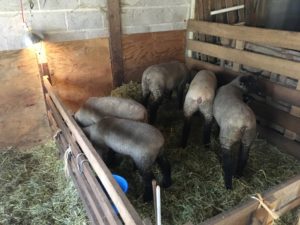Main Content

When lambs are born, usually on the one of the coldest days of the year, they need to get nourishment within the first hour of birth. The mother’s first milk (colostrum) “comes in” by the time the lamb(s) are ready to nurse. If not, be prepared to supplement with a powdered colostrum from your local feed store. They may drink about 4-6 oz. By the time they’re hungry again, make sure all is well and the lamb knows where to find the milk at the ewe’s teats.
After a few days in a lambing pen with their mother, they are ready to mix with a few additional mothers. The lambs will nibble at tender leafy hay, preferably alfalfa, and taste some grain. Have a creep area set up for them to explore and be safe from the other mothers in the flock. The creep area is where the lambs can go and the mothers cannot. It should have free choice grain, tender leafy hay, and fresh clean water at all times.
When lambs are a couple of weeks old, they will start eating grain. This will promote their rumen and digestive system to develop. Many feed stores sell a prepared feed specifically for the very young lambs that is higher in protein and other nutrients they need at this age.
By the time the lambs are 6-8 weeks of age, they are ready to be weaned and should be eating a feed that is about 16-18% protein. They should continue to have high quality hay with tender leaves such as second cutting alfalfa along with a prepared feed for their age. By the time the lambs are weaned, especially market lambs, they should weigh 40-50 lbs.
When selecting a market lamb, it should be heavily muscled, have a long loin, and be good boned to support its frame. In order for lambs to grow well, there should be at least two in the group as sheep should always have a companion. They don’t grow as well without a companion.
The lambs will eat up to 3+lb/day of grain, plus hay, and plenty of fresh clean water. They will also need a shelter to protect them from the weather and hot sun and a pasture for exercise.
Shearing the lambs in the late spring will also help them to grow better as they will be more comfortable in the hot summer. All lambs should be weighed, wormed, and have their feet trimmed once a month to make sure they are growing at a steady rate. By fair time the lambs should be 5-7 months old and weigh approximately 100-140 lbs.
By Susan Miller, Hunterdon County 4-H Club Leader, Rutgers Cooperative Extension